The number of vessels allowed to pass through the Panama Canal is being limited due to the driest October since 1950.
The temporary restrictions are likely to increase the financial cost to businesses of transporting goods around the world and could delay some goods reaching their destination, according to BCG’s shipping lead Peter Jameson.
In normal times, between 36 and 38 vessels pass through the canal each day. The number of booking slots is being steadily reduced until February 2024 when there will only be 18 available slots—half the normal level of traffic.
The Panama Canal Authority says the El Niño weather phenomenon is to blame for the “unprecedented” low water levels. The temporary restrictions will help guarantee water supply for the population as well as maintaining the operations of the waterway, it says.
The So What
What is happening in Panama demonstrates how extreme weather can disrupt transport routes and supply chains.
“The financial cost of extreme weather is already taking a toll. Discussions about who will pay for low-carbon solutions often dominate the agenda. This needs to change in order to factor in the financial cost of not taking action,” says Jameson.
“From floods to damaged infrastructure or failed crops, the cost of climate change to business is real and the bills are starting to arrive.”
Other recent examples of drought impacting supply chains include:
- Waterways feeding into the Amazon are too low for conventional vessels at present. This impacts global agricultural prices, such as soy, as well as the local economy.
- Germany’s Rhine and Italy’s Po became impassable in the summer of 2022. This year, low water levels have restricted the amount of cargo vessels can carry on the Rhine.
- There has also been disruption to barge travel at the Mississippi River, which is crucial to US grain exports.
“The restricted waterways at the Panama Canal could delay some goods reaching market, as well as force some shippers to employ new routes, and is one tangible example of the financial burden of extreme weather events on businesses,” says BCG Project Leader Laurids Schack.
Some 55% of all container ships moving from Asia to the US pass through the Panama Canal. In normal conditions, more than 13,000 vessels travel through the canal each year, serving 170 countries and connecting almost 2,000 ports.
Now What
According to Jameson, business leaders should:
Diversify Routes to Market and mitigate risks around longer wait times and weight restrictions. In the short-term, this could include:
- Having storage on both the US East and West coasts to bypass the canal.
- Using railways rather than shipping.
- Transparent pricing models that pre-warn customers about extra charges in case of delays.
Adapt Vessels and Waterways. In the medium term, there are adaption strategies to build out the canal and connect it to more waterways on Panama’s mainland. Shipping companies should also consider the size of vessels in their order book, as well as committing to reduce their own emissions. BCG’s partnership with the Mærsk Mc-Kinney Møller Center for Zero Carbon Shipping and the Global Center for Maritime Decarbonization offer solutions to accelerate action in this respect.
Plan for more Extreme Weather Patterns Disrupting Waterborne Freight.
Current climate models indicate that global warming increases evaporation and intensifies the Earth’s water cycle. This leads to more intense storms, with an increased risk of flooding in some places and increased risk of drought in others. Scientists also say we have entered a period when the El Niño weather phenomenon is active. This further impacts extreme weather events, amplifying both storms and droughts.
Re-emphasize the Financial Case for Climate Action. Leaders should use their voice to stress the financial imperative of action at gatherings such as COP28 and Davos. A report from the US Environmental Protection Agency has found the social cost of emitting a metric ton of CO2 in 2030 will cost between $140—$380. That is above the abatement costs for many decarbonization levers such as the Inflation Reduction Act in the US, Jameson explains.
“When looking at the business case toward the transition to a low-carbon future, the cost of not taking action should also be included. That’s when the business case for action will become clear,” he says.






